The habit of looking at things microscopically as the lichens on the trees & rocks really prevents my seeing aught else in a walk.—Henry David Thoreau
I should have loved an opportunity to go for a walk in the woods with Thoreau—especially during the winter when my preoccupation with insects no longer restrains my fascination with all things natural. While many entomologists see winter as a break from field work—a time to indulge/suffer (depending on mood) the more mundane curatorial tasks associated with their studies, my time in the field continues uninterrupted with long walks in the woods. Hiking stick replaces insect net. Energy foods replace vials. I still pry bark and flip rocks—I cannot completely ignore the potential to find insects. But I also peer through miniature forests of moss, poke about the mushrooms on a fallen log, and squint at the lichens encrusting a rock. Yes, insect specimens collected during the previous summer still need to be pinned, but there is time for that. There will always be time for that—if not now then in my later years when my ability to scramble through the bush begins to wane. For now, the woods sing their siren song, and I must listen.
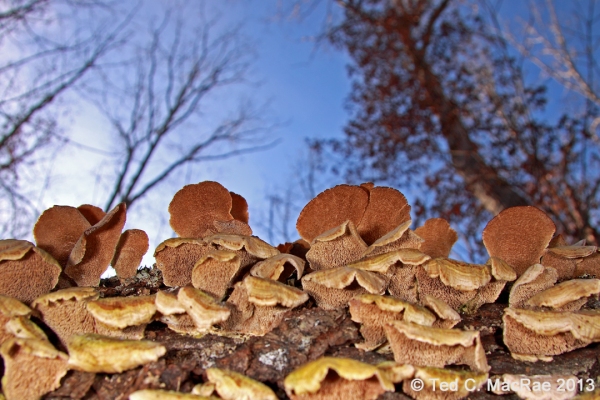
Trichaptum biforme on fallen trunk of Betula nigra | Reynolds Co., Missouri

Trichaptum biforme on fallen branch of Acer rubrum | Reynolds Co., Missouri
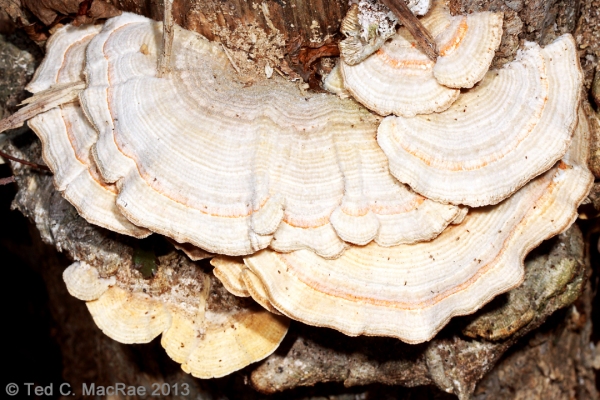
Lensites betulina on dead stump of Betula nigra | Reynolds Co., Missouri
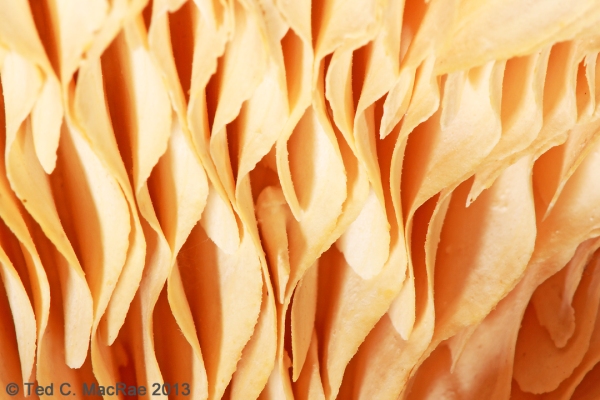
“Gills” distinguish this shelf fungus from turkey tails and other similar types.
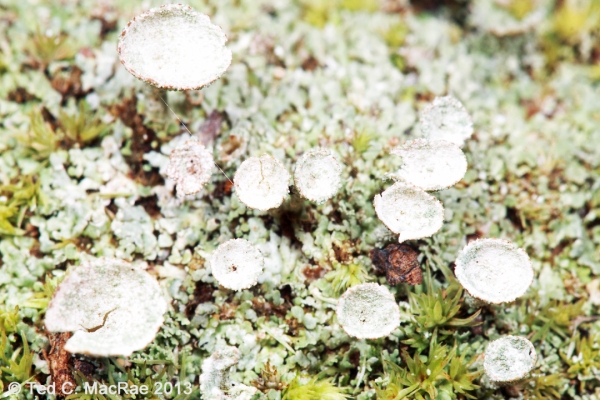
Cladonia sp. (poss. C. chlorophaea or C. pyxidata) on chert-trail | Reynolds Co., Missouri
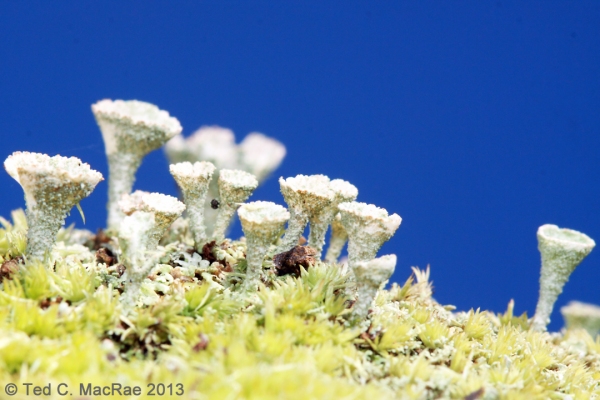
A forest in miniature!

Irpex lacteus (?) on fallen branch of Acer rubrum | Iron Co., Missouri
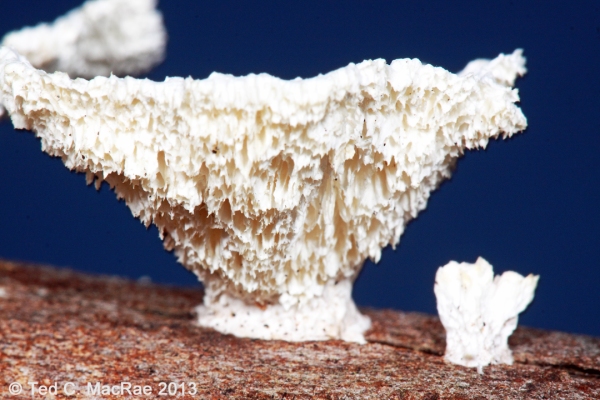
Spores are released from the toothy cap underside

Leucobryum glaucum on forest floor | Reynolds Co., Missouri
Postscipt: all photos shown taken on 30 November 2013 while hiking a 7-mile stretch of the Ozark Trail (Karkaghne Section in Reynolds Co. and Middle Fork Section in Iron Co.).
Copyright © Ted C. MacRae 2014
This is great, Ted! Just the kind of thing I want to get into more frequently as well. Now if it were only not -30 deg. C outside at the moment…
We’re in the midst of a winter storm here, as well—tomorrow’s forecast high is -3° F. So, I am actually getting some specimen work done today! 🙂
Great stuff, Ted. Do you have a recommendation for a lichen guide?
Lichens of North America is a good place to start, but I highly recommend going ahead and getting the book! It covers all species in North America and is filled to the brim with stunning color photographs of most species.
Thanks. I’ll be sure to check these out. It would be nice to get some identifications for the lichens in patruela habitats.
I’m just looking forward to the day when I get to see patruela itself!
You’ll just have to visit the northeast sometime. Probably a few other species you could pick up also. Let me know if you’re ever out this way.
Definitely—there are quite a few NE tigers on my photo-wish list (rugifrons, hentzi, ancosisconensis, marginipennis… the list goes on).
You’re at the top of my list of resources whenever I can manage to get out that way.
so beautiful!!!
🙂
Great post, Ted. I like hiking the same trails or visiting the same places in different seasons. There’s something new to see all the time. And without the distractions of insects, or flowers, or leaves, things like fungi and lichens and rocks and bark become so much more visible. Even the changes in shapes of snow and ice in winter. Someday, when I have no other mundane responsibilities, I’d like to spend a year walking the same route every day. 365 different little worlds.
Yep, you get it—we are kindred spirits, Terry!
it remains 80 deg F down here in south Florida. That means tiger beetles are still evading me on the coast in January and Phanaeus vindex is still getting caught in the pool filter. All that warmth means wood decay continues unabated all year long, so we are always blessed with an abundance of fungi. A morning’s exercise walk yields such gems as jelly ear, lattice stinkhorn, bird’s nest fungus, slime mold, and much more. Most people don’t look, but I spend half the walk snapping cell phone photos so I can debate fungus IDs with my son-in-law, who works for Fairchild Tropical Botanic Gardens. Always an enjoyable pastime. Great photographs, Ted.
I don’t know what I would do with 80 °F temps year-round! I already suffer from too many groups of interest—seeing all those cool fungi as well just might cause my brain to finally short circuit… 🙂
Know any good fungus ID resources? I’ve been using MushroomExpert.com, but you have to kind of already know what you’ve got when using that site.
I typically use books rather than the Internet when searching for fungus IDs, as they allow easier browsing. “The Book of Fungi,” by Roberts and Evans (University of Chicago Press) covers 600 species with excellent color photography. While not an academic volume, it nearly always gets me to family or genus, and I can use that to refine identifications on-line. The “Simon & Schuster’s Guide to Mushrooms” is also OK, and it’s field-totable.
Great, thanks. Books is what I was looking for.
Well written. Love the Thoreau quote as well. Pretty much explains me. Love the ‘gills’ pic also.
Thank you very much!
Ah, winter wildflowers. Not mush up in CA yet, since we haven’t had any rain. I think most Mycos call David Arora’s books “Mushrooms Demystified,” and “All the Rain Promises” the gold standards. I find them to be quite good (even though many of the species out west are being reclassified and separated from the eastern species). As you say, Mushroomexpert.com is a good online resource, and we also have the excellent Fungi of CA at MykoWeb.com.
Shrooms may be scarcer out your way, but oh the lichens!
Thanks for the book tips, I’ll check them out.
Yes, we do have fab lichens. But most of them need rain too, and we’ve had none.
True, at least to be colorful. But at least you can still find them when it’s dry.
Shouldn’t you be getting rain about now?
It’s actually getting quite worrying, Ted. Our snowpack and reservoirs are sub 20%. If CA doesn’t get some big spring rains, this whole country could feel it, because our ag and livestock are going to get slammed. There’s no grass up in the San Joaquin Valley – it’s still all dirt.
Btw, I did a fungi post last year about this time, if you’d like to see a few of our CA species.
Those were some fab photos and incredible-looking species.
We are fans of lichen, too. Your photographs are artful. But we are especially pleased to find your site preoccupied with a healthy attitude for bugs. Looking forward to further reading. – The Healing Garden gardener